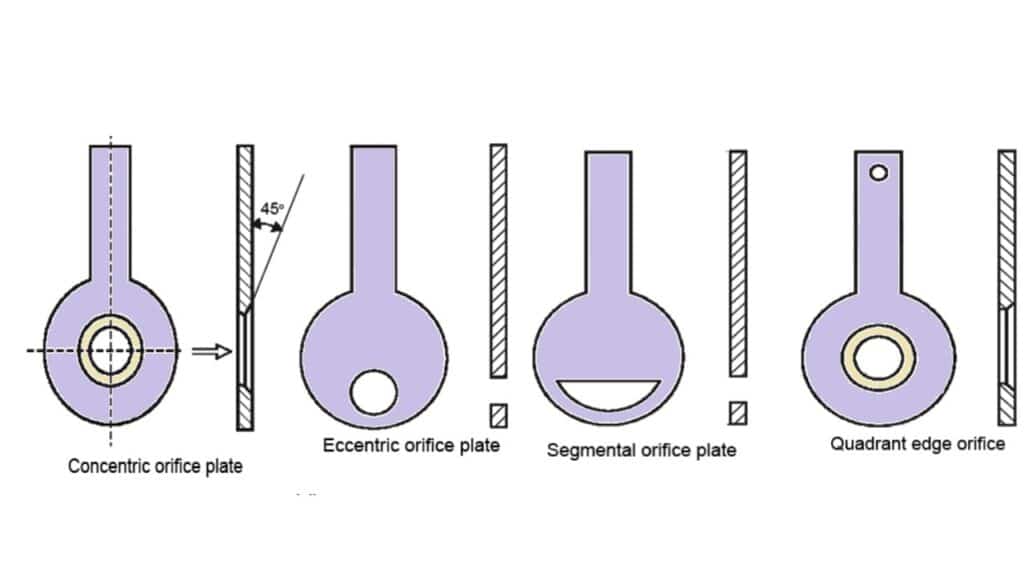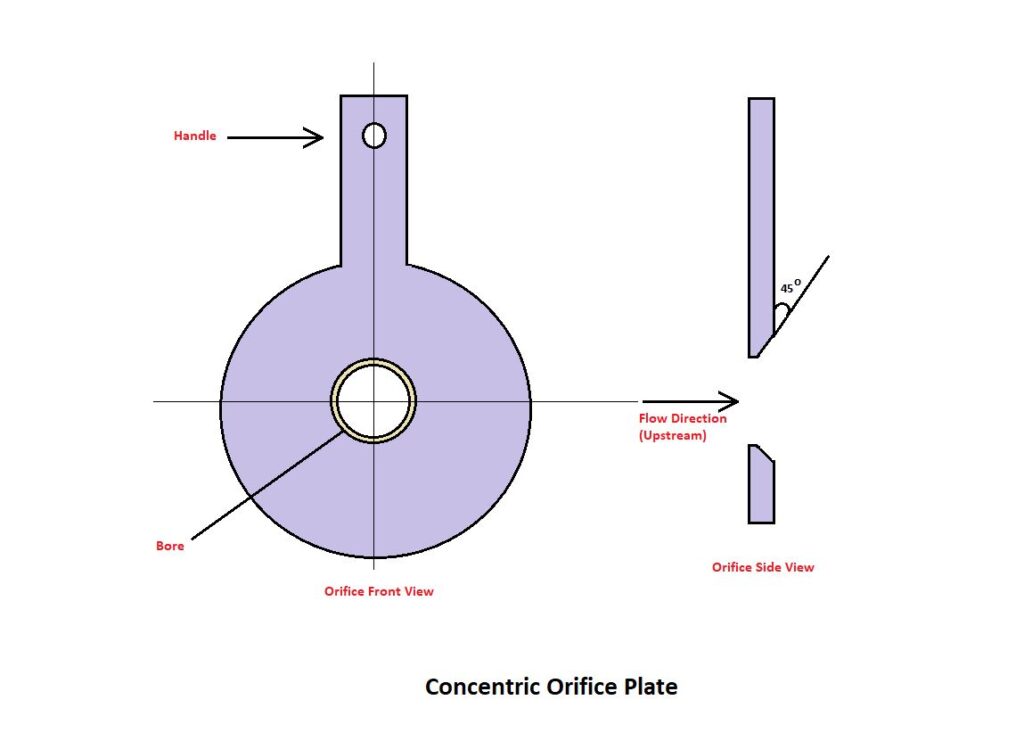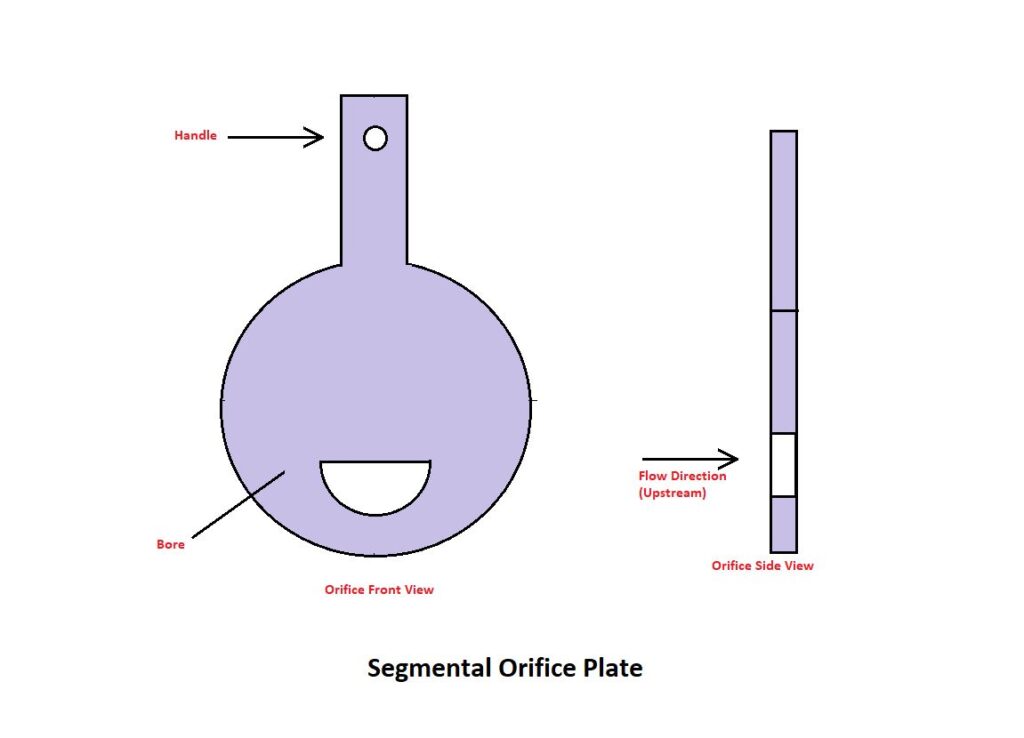Table of Contents
The orifice plate, simply a circular plate with a small hole in the middle is one of the most popular instruments for the measurement and control of fluid flow. The orifice is used to measure the flow; this plate is usually fixed between the two flanges. When the flowing fluid tries to pass through a small hole in the orifice, which has a 45 degree edge so that there is some pressure drop and vena Contract is formed. The size and construction tolerances of plates used in measurement applications are defined in the international standardization publications of ISO, AGA, ASME and others.
In flow control applications, orifice plates are used as restriction devices to regulate fluid flow or reduce the pressure downstream of the orifice plate. The use of a fixed restriction orifice can be beneficial and economical by reducing the demands on other flow system components.
Orifice plates are typically mounted between a set of orifice flanges and installed in straight runs of smooth pipe to avoid disturbance of flow patterns from fittings and valves.
Before knowing the type of orifice, let us know about some parameters of orifice.
What is beta ratio in orifice?
What is Vena Contrata in orifice?
- Beta Ratio
- Vena Contracta
Beta Ratio: – Beta Ratio is determined by dividing the inner diameter of the orifice bore by the inner diameter of the pipeline. It is always less than 1.

Vena Contracta: – After passing the fluid from the orifice where the pressure is lowest and the flow is highest.




Orifice plate types:-
Orifice Plate are very common in industry . They are simple in construction and easy to use. According to different design orifice are many type that is given below.





Concentric orifice Plate
The standard concentric plates is usually made of stainless steel from 1/8 to ½ inch thick, depending primarily on the line size. Materials (nickel, monel, haste alloy
etc.) are used to prevent corrosion or contamination. A tab is usually built on to the plate on which is stamped pertinent orifice plate data (identification, bore size,
etc.). some flow orifices are made with one side of the hole bevelled at a 45 degree angle. The sharp or unleveled edge should be mounted in the line facing the flow to
minimize friction, resistance as the flowing fluid passes through the restriction. The plate thickness is usually a function of the line size. Its thickness at the orifice edge should
not exceed D/50, d/8, (D-d)/8
Where D = Pipe ID, d = The orifice ID or base.
The plate may be made thicker than indicated by the above criteria by beveling the Downstream edge at 45 degree or less to the required thickness.





Concentric orifice plates may be provided with drain holes to prevent the build-up of trapped liquids in gas streams, or with vent holes to drain the entered gases from the fluid. The unimpeded flow passing through a vent or drain hole is typically less than 1% of the total flow if the hole diameter is less than 10% of the orifice bore. The effectiveness of vent/drain holes is limited, however, because they often plug up.
Eccentric orifice plate
Eccentric orifices are bored tangents to a circle concentric with the pipe and of a diameter equal to 98% of that of the pipe. Other specifications relative to thickness, sharpness, smoothness and flanges are the same as for concentric orifices. Location of the bore prevents deeming of solid materials or foreign particles and makes it useful for measuring fluids containing solids, oils, containing water and wet steam. Eccentric plates can use either flange or vena contacta tapes, but the tap must be at 180 degree or 90 degree to the eccentric opening. The vena contacta are different from those the concentric plates and in general, the possible error can be up to five times greater than on concentric plate.





Segmental orifice plate:
Segmentally bored plates are used for the same type services as the eccentric orifice plate. The opening is a segment of a circle. The segmental opening may be placed either at the diameter of which is customarily 98% of the pipe diameter top or bottom.





Quadrant Edge Orifice plate
The quadrant edge or quadrant round orifice plate is constructed such that the edge is rounded to form a quarter circle. The plate has of concentric opening with of rounded up
stream edge rather than the sharp square edge normally used. Test indicates that this type plate produces a coefficient of discharge, which is particularly constant in the low
Reynolds number or viscous flow region. The square round orifice may be used when the live Reynolds number range from 100000 or above down to 3000 to 5000
(depending up on beta ratio) with a coefficient accuracy of approximately 0.5%. This plate is used for flows such as heavy crude, syrups and slurries and viscous flow having
Reynolds number bellow 100000.





Ring Type Joint (RTJ) Orifice Plates – RTJ type orifice plates include a necessary gasket for mounting between ring type joint flanges. It is based on proven technology, has no moving parts and is suitable for high temperature and pressure applications. Orifice plates are recommended for clean liquids, gases and low velocity steam flows. The plate thickness depends on the line size and differential pressure, and must be sufficient to prevent the plate from bending under operating conditions.
Orifice Performance
Although it is a simple device, in principle, the orifice plate is a precision instrument. Under ideal conditions, the inaccuracy of a pore plate can be in the range of 0.75–1.5% AR. However, orifice plates are quite sensitive to a variety of error-inducing conditions. The accuracy in the calculation of bore, the quality of installation and the position of the plate itself determine the overall performance. Installation factors include tap location and position, process pipe position, adequacy of straight pipe runs, gasket interference, misalignment of pipe and orifice holes, and lead line design. Other adverse conditions include dulling of sharp edges or nicks due to corrosion or corrosion, warping of the plate due to waterhammer and dirt, and either grease or secondary phase deposits on the surface of the pore. Any of the above conditions can change the orifice discharge coefficient by up to 10%. In combination, these problems can be even more worrying and the net effect can be unpredictable. Therefore, under average operating conditions, a typical orifice installation can be expected to have an overall inaccuracy in the range of 2 to 5% AR.
Read Also
- Orifice meter
- Orifice Plate Bore Size Calculation
- Turndown ratio of orifice flow meter
- Type of Orifice Tapping Connection
- Why Orifice Drain hole Required ?